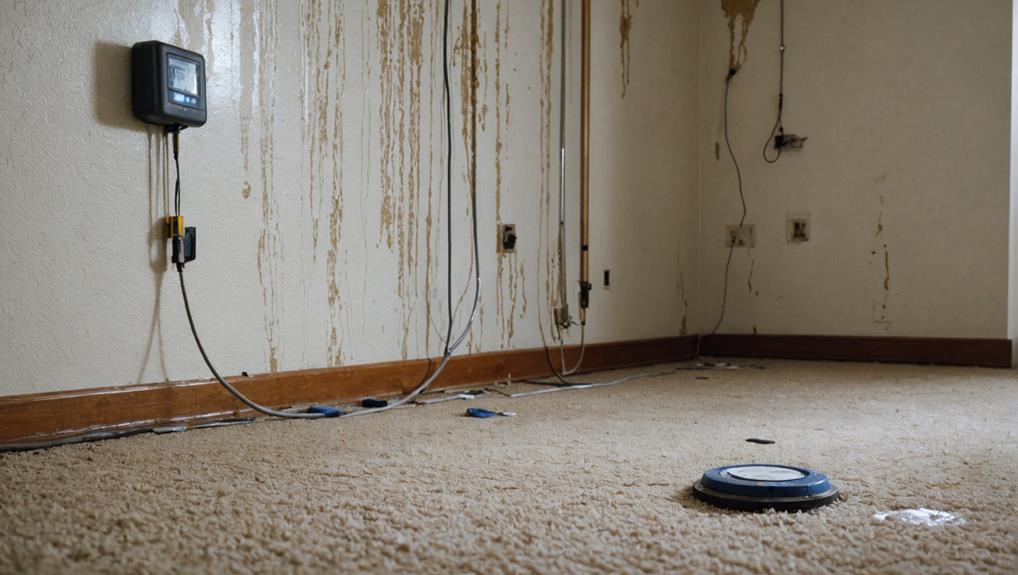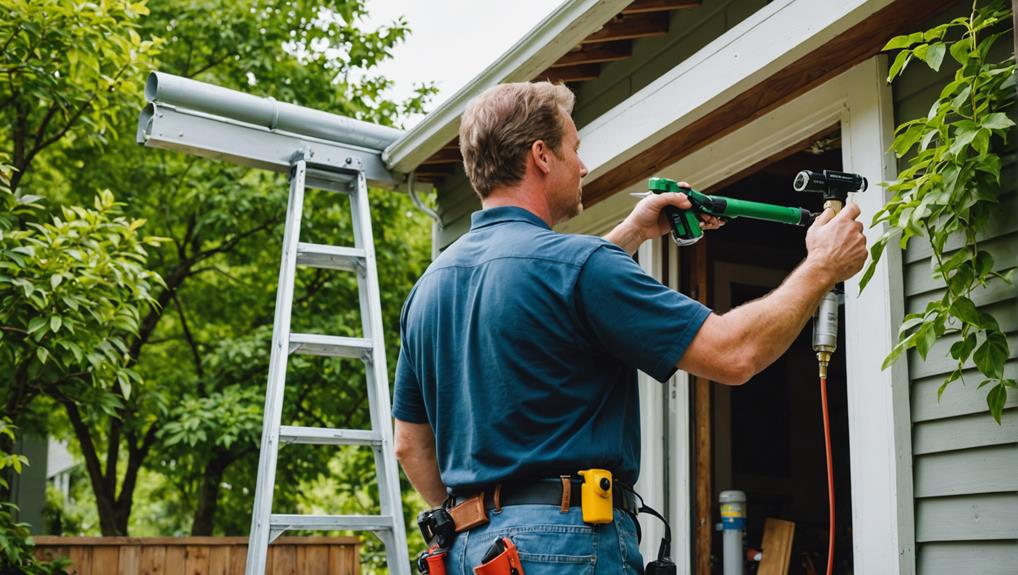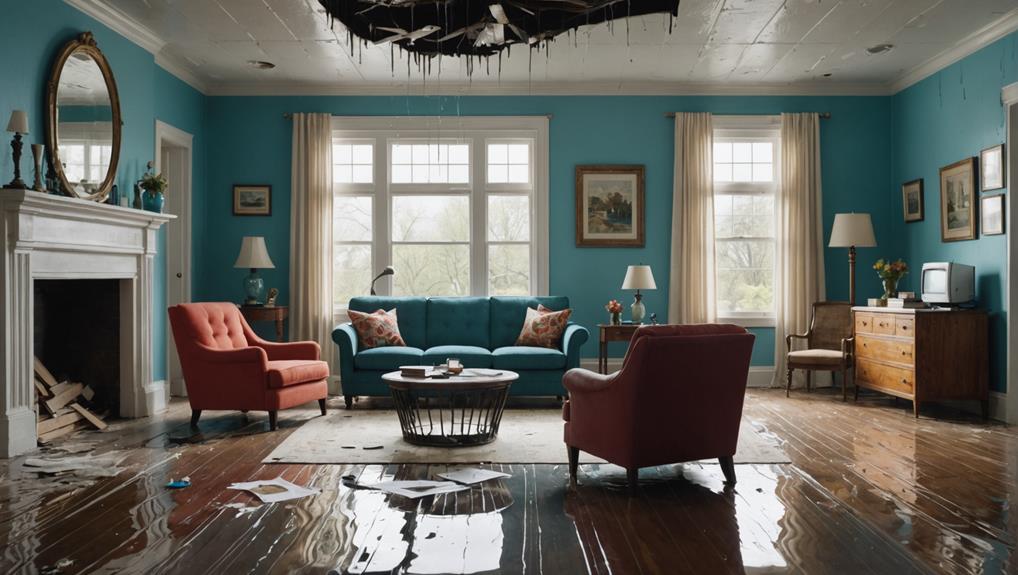Water damage can hit your wallet hard, with average repair costs around $2,500. To avoid this, keep an eye out for warning signs like unexplained stains or sudden spikes in your water bill. Regular inspections of your plumbing and roof can spot issues before they escalate. Don't forget to clean your gutters and control indoor humidity to prevent mold. If damage does occur, act quickly: shut off the water supply and document everything for your insurance claim. Want to protect your home and finances even further? There's more valuable info just ahead!
Understanding Water Damage Risks

Water damage can strike when you least expect it, and understanding the risks is vital for any homeowner. You might think your home is safe, but various water sources can lead to unexpected issues. It's important to recognize these potential hazards to protect your space and your wallet.
One common risk comes from the plumbing system. Leaks in pipes, faucets, or toilets can create significant damage over time, often hidden behind walls or under floors. Another major culprit is the roof; damaged shingles or gutters can allow water to seep in.
Humidity levels in your home likewise play a vital role. High humidity can lead to condensation, promoting mold growth and structural issues. Maintaining a balanced humidity level between 30% and 50% not only improves comfort but additionally helps prevent damage.
Regularly inspecting your property and addressing any signs of moisture can save you from costly repairs. By staying informed about these risks, you can take proactive steps to safeguard your home, ensuring it remains a safe haven for you and your loved ones.
Signs of Potential Water Issues
You might notice some signs around your home that indicate potential water issues. Unexplained water stains, musty odors, and a sudden spike in your water bills can all be red flags. Keeping an eye out for these symptoms can save you from more extensive damage down the road.
Unexplained Water Stains
The presence of unexplained water stains can be a troubling sign of underlying issues within your home. These stains, often appearing on ceilings, walls, or floors, shouldn't be ignored. They can stem from various water stain causes, such as leaky pipes, roof damage, or even condensation. Identifying the source is vital; otherwise, the problem could worsen, leading to more extensive damage and higher repair costs.
Once you've pinpointed the cause, it's time to investigate your repair options. If the issue is a minor leak, a quick fix might be all you need—perhaps sealing a joint or replacing a section of piping. Nonetheless, if the stains are a result of roof issues or significant plumbing problems, you may need to call in professionals. They can provide a thorough assessment and guarantee that the underlying cause is properly addressed.
Musty Odors Present
When musty odors start creeping into your home, it's often a sign that moisture issues are lurking beneath the surface. Ignoring these telltale smells can lead to more significant problems, including mold growth that can affect your health and your wallet. It's vital to pay attention and act quickly to protect your home.
Here are a few signs to look out for:
- Unexplained dampness in corners or behind furniture
- Visible mold growth on walls, ceilings, or floors
- Increased humidity levels in the air
If you detect musty odors, take immediate action. Start by identifying the source of the moisture. Check for leaks in plumbing, roofs, and windows. Guarantee proper ventilation, especially in areas like basements and bathrooms. If you do find mold, remember that it's critical to address it promptly to prevent further spread.
Don't let musty odors become a permanent feature in your home. By staying vigilant and proactive, you can tackle potential water issues before they escalate, keeping your space healthy and inviting. Your home deserves it!
Increased Water Bills
A sudden spike in your water bills can be more than just an unwelcome surprise; it often signals hidden water issues within your home. You might not see the leaks, but they can silently drain your resources and inflate those bills. By staying vigilant, you can catch these issues before they escalate.
Here's a quick guide to help you identify potential water problems:
| Signs of Increased Water Bills | Action Steps |
|---|---|
| Unexpected bill increase | Conduct leak detection |
| Damp spots on walls or ceilings | Inspect plumbing fixtures |
| Unexplained puddles outdoors | Check irrigation systems |
Implementing simple conservation methods can likewise make a difference. Fixing leaky faucets or toilets not only saves water but likewise keeps your bills in check. Regularly monitor your water usage, and consider investing in water-efficient appliances. Your wallet—and the environment—will thank you for it. Remember, being proactive about potential leaks can prevent further damage and unwanted expenses down the line. Take the time to assess your home and make those small changes that lead to significant savings.
Preventive Maintenance Strategies

Implementing preventive maintenance strategies can greatly reduce the risk of water damage in your home. By being proactive, you can save yourself from costly repairs down the line. Here are some crucial tips to keep your home safe:
- Schedule seasonal inspections: Regularly check your roof, gutters, and downspouts for any signs of wear or blockages. Catching issues early can prevent bigger problems later on.
- Invest in plumbing upgrades: Consider replacing old pipes and fixtures with modern, more durable materials. This can minimize leaks and increase efficiency.
- Monitor humidity levels: Use dehumidifiers in damp areas like basements to prevent mold growth and water damage. Keeping humidity in check can make a significant difference.
Emergency Response Steps
In the event of water damage, quick action can make all the difference in minimizing harm to your home. First, don't panic; take a deep breath and assess the situation. Identify the source of the water—whether it's a burst pipe, a leaky roof, or flooding. Once you've done that, it's time for immediate actions. If it's safe, shut off the main water supply to prevent further flooding.
Next, grab your emergency contacts—this includes a trusted plumber or water damage restoration service. Call them right away; the sooner they arrive, the better. While waiting for help, begin to remove any valuables or furniture from the affected area. Use towels or mops to soak up excess water, but avoid using electrical appliances until everything is dry.
If you notice any electrical hazards, prioritize safety and turn off the power. Document the damage with photos for future reference. Remember, acting swiftly can save you time, money, and stress in the long run. Your home deserves the best care, so don't hesitate—take those immediate actions to protect your space.
Insurance Policy Insights

When dealing with water damage, it's essential to understand your insurance policy's coverage limits. You don't want to be caught off guard by unexpected out-of-pocket expenses. Plus, documenting the damage properly can make a significant difference in how quickly and efficiently your claim gets processed.
Understand Coverage Limits
Understanding your insurance coverage limits is vital for effectively managing water damage claims. You want to be fully aware of what your policy covers and where it might fall short. This knowledge can save you from unexpected expenses and stress during an already challenging time.
Here are a few key points to take into account:
- Coverage options: Different policies offer varying levels of protection. Familiarize yourself with what's included, whether it's dwelling coverage or personal property protection.
- Policy exclusions: Be clear about what's not covered. Many policies exclude certain types of water damage, like flood damage, so knowing these exclusions is significant.
- Limits on payouts: Each policy has maximum payout limits for specific types of damage. Confirm you know these limits to avoid being left in the lurch.
Document Damage Properly
After grasping your insurance coverage limits, the next step is to document the damage properly. This step is essential for a smooth claims process and guaranteeing you're compensated adequately. Start with clear photographs of the affected areas, capturing the extent of the damage. Use documentation techniques like close-ups and wide angles to provide a thorough view.
Once you've taken pictures, create a detailed list of damaged items and areas. Include descriptions, purchase dates, and estimated costs for repairs or replacements. This damage assessment not only strengthens your claim but helps you remember all the details when speaking with your insurer.
Don't forget to keep receipts for any repairs you undertake immediately. These receipts serve as proof of your expenses and can be critical in your claim. Finally, consider keeping a journal to note any conversations you have with your insurance company, including dates and names. This personal log helps you track the progress of your claim and guarantees no detail slips through the cracks. By being thorough in your documentation, you're taking a proactive step to safeguard your finances and restore your peace of mind.
Cost-Effective Repair Solutions
Water damage can be a frustrating experience, but finding cost-effective repair solutions can make the process much easier. You don't have to spend a fortune to restore your home. Consider these DIY repairs that utilize affordable materials, ensuring you stay within budget while tackling the damage.
- Assess the Damage: Start by identifying the source of the water and any affected areas. This will help you prioritize repairs and avoid further issues.
- Use Affordable Materials: Look for low-cost options like plywood or drywall for replacements. You can often find discounted items at local home improvement stores.
- Seal and Paint: Once you've made repairs, using a good sealant can prevent future leaks. A fresh coat of paint not only improves aesthetics but also protects surfaces from moisture.
Approaching repairs with a DIY mindset not only saves you money but also gives you a sense of accomplishment. Plus, it's a great way to learn new skills. So roll up your sleeves and get started—your wallet will thank you!
Long-Term Damage Prevention Tips

To keep your home safe from future water damage, it's vital to adopt proactive measures that can save you time and money in the long run. Start by ensuring your drainage systems are functioning properly. Regularly check gutters and downspouts to prevent water from pooling around your foundation. If you notice clogs or damage, address them immediately.
Next, pay attention to humidity control within your home. High humidity levels can lead to mold growth and structural damage. Invest in a dehumidifier for areas prone to dampness, like basements or bathrooms. Make it a habit to monitor indoor humidity levels; ideally, they should stay between 30-50%.
Don't forget to inspect your home's exterior for cracks or gaps where water might sneak in. Seal any openings to keep moisture at bay. Finally, consider scheduling annual inspections with a professional to identify potential water issues before they escalate. By taking these steps, you'll not only protect your home but likewise create a safer, more comfortable environment for you and your loved ones. Remember, a little preventive care goes a long way!
Conclusion
Don't let water damage catch you off guard. By staying vigilant and taking proactive steps, you can save yourself from costly repairs. For instance, imagine a family who ignored a small leak, only to find their basement flooded months later, costing thousands in repairs and lost memories. By addressing issues early, you can protect not just your wallet but your home's heart. Stay informed, act swiftly, and keep your home safe from water's destructive reach.
